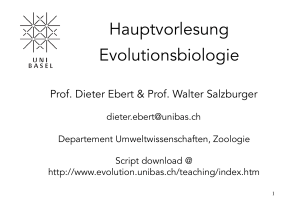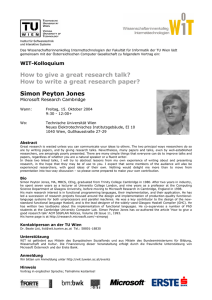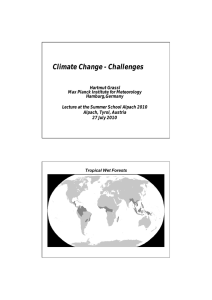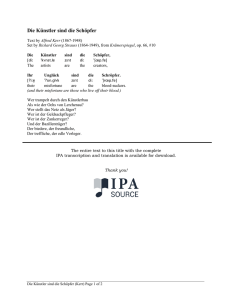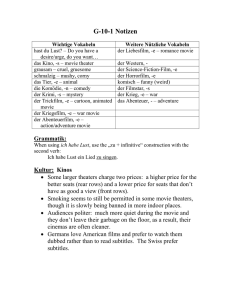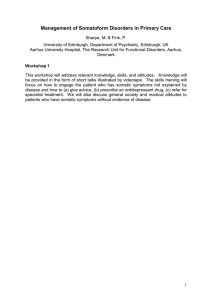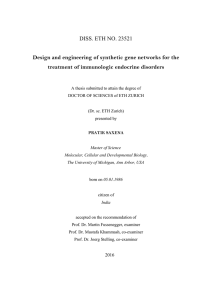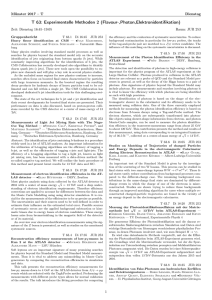Hauptvorlesung Evolutionsbiologie
Werbung
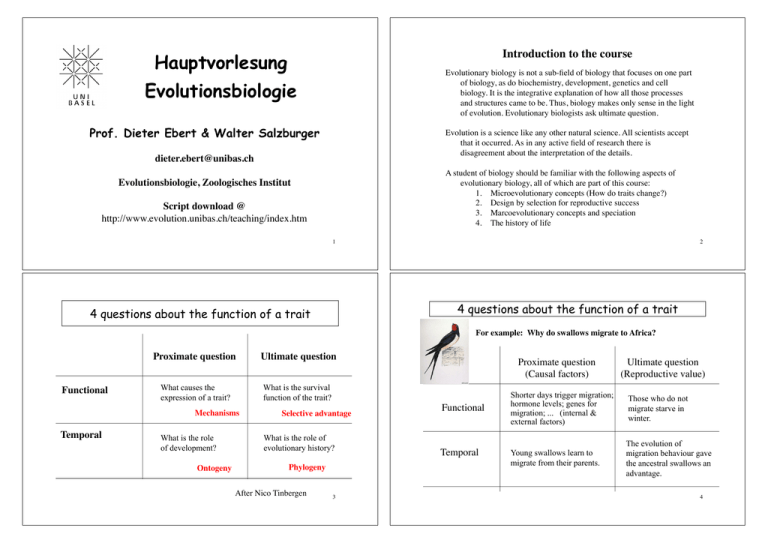
Introduction to the course Hauptvorlesung Evolutionary biology is not a sub-field of biology that focuses on one part of biology, as do biochemistry, development, genetics and cell biology. It is the integrative explanation of how all those processes and structures came to be. Thus, biology makes only sense in the light of evolution. Evolutionary biologists ask ultimate question. Evolutionsbiologie Prof. Dieter Ebert & Walter Salzburger Evolution is a science like any other natural science. All scientists accept that it occurred. As in any active field of research there is disagreement about the interpretation of the details. [email protected] A student of biology should be familiar with the following aspects of evolutionary biology, all of which are part of this course: 1. Microevolutionary concepts (How do traits change?) 2. Design by selection for reproductive success 3. Marcoevolutionary concepts and speciation 4. The history of life Evolutionsbiologie, Zoologisches Institut Script download @ http://www.evolution.unibas.ch/teaching/index.htm 1 2 4 questions about the function of a trait 4 questions about the function of a trait For example: Why do swallows migrate to Africa? Functional Proximate question Ultimate question What causes the expression of a trait? What is the survival function of the trait? Mechanisms Temporal What is the role of development? Ontogeny Selective advantage What is the role of evolutionary history? Phylogeny After Nico Tinbergen 3 Proximate question (Causal factors) Functional Temporal Ultimate question (Reproductive value) Shorter days trigger migration; hormone levels; genes for migration; ... (internal & external factors) Those who do not migrate starve in winter. Young swallows learn to migrate from their parents. The evolution of migration behaviour gave the ancestral swallows an advantage. 4 Charles Darwin 1809 - 1882, British Naturalist The big question: 1825 - 1830 Studied Medicine, Theology and Natural Sciences in Edinburgh and Cambridge. How do species originate? 1831 - 1836 Expedition around the world on board of the ship Beagle. ? Wolves Jackals ---> Darwin’s answer to this question ... 12. Feb. 1809 Charles Darwin 1809 - 1882 1840 - 1880 Wrote several books on natural history of various groups and on the geology of coral reefs and volcanoes. 5 Charles Robert Darwin wird in Shrewsbury, etwa 60 km nord-westlich von Birmingham geboren. Sein Vater ist ein gebildeter und wohlhabender Arzt. Sein Grossvater war der bekannte Naturwissenschaftler Erasmus Darwin. Bis 1825 Darwin durchlebt seine Schulzeit als mittelmässiger Schüler. 1825-1827 Erfolgloses Studium der Medizin. Darwin zeigt ein vertieftes Interesse für Natur. 1827-1831 Studium der Theologie in Cambridge. Kontakt zu dem Naturwissenschaftler John Henslow, der seine Interessen an Botanik, Insektenkunde und Geologie fördert. 1831-1836 Auf der Reise mit dem Vermessungsschiff Beagle besucht Süd-Amerika, Australien, Süd-Afrika und viele isolierte Inseln, unter anderen die Galapagos Inseln, die Falkland Inseln und Tahiti. Die Reise prägt sein Verständnis für die geologische Dynamik der Erde und für die biologische Vielfalt. 1936-1838 Nach seiner Weltreise begann Darwin seine Ideen über die Veränderbarkeit der Arten zuentwickeln. Eine Schlüsselerlebnis war die Lektüre von Thomas Robert Malthus Buch über Populationsdynamik ("An Essay on the Principle of Population"). Nach Malthus vermehrt sich der Mensch schneller als seine Nahrungsgrundlage zunimmt. Das führt zu Konkurenz, Hungersnöten und Krankheiten. Darwin wendete diesen Gedanken auf Pflanzen und Tiere an. Bereits im Jahre 1838 hatte er seine Idee zur Evolution durch natürliche Selektion klar umrissen. 1839 Darwin heiratet seine Cousine Emma Wedgwood. Sie hatten zehn Kinder, von denen drei noch im Kindesalter starben. 1842 Umzug von London nach Kent. Bis zu seinem Lebensende wird er dort im Down House wohnen bleiben. 1838-1858 Darwin arbeitet langsam seine Idee zur Artentstehung aus. In dieser Zeit veröffentlicht er zahlreiche Bücher, darunter eine Reisebeschreibung seiner Fahrt auf der Beagle, und mehre Bände zur Biologie der Rankenfusskrebse. 1858 Darwin erhält ein Manuskript des Naturforschers Alfred Russel Wallace, in dem dieser seine Idee zur Entstehung der Arten erklärt. Diese Idee ist weitgehend identisch mit Darwins Idee. An einer Sitzung der Linne Gesellschaft (Linnean Society) wird dieses Manuskript zusammen mit einer Kurzfassung von Darwins Entstehung der Arten verlesen. Aufgrund früherer Äusserungen und Briefe von Darwin, wird Darwin aber als Urheber der Theorie anerkannt. 24. Nov. 1859 Darwin veröffentlicht sein Buch über die Entstehung der Arten. Es folgen sechs weitere Auflagen. 1862-1872 Darwin veröffentlich eine Reihe weiterer Bücher zur Evolution: 1862: Über die Einrichtungen zur Befruchtung Britischer und ausländischer Orchideen durch Insekten und über die günstigen Erfolge der Wechselbefruchtung. 1868: Das Variieren der Tiere und Pflanzen im Zustande der Domestikation. 1871: Die Abstammung des Menschen und die geschlechtliche Zuchtwahl. 7 1872: Der Ausdruck der Gemütsbewegungen bei dem Menschen und den Tieren. 6 In 1859 Charles Darwin published his most important book: 'The origin of species by means of natural selection' 1854 8 Population divergence and speciation Darwin’s theory of evolution can be understood in 5 steps: New subpopulation 1. Individuals within species differ in various traits, for example: colour, morphology, size, behaviour ...) Ancestral population time 9 10 On average offspring resemble their parents and sibs more than other individuals of the population. 2. Some of this variation is heritable. On average, offspring resemble their parents more than other individuals of the population. Mother and offspring Brothers and sisters Height of offspring (cm) The basis of Darwinian evolution 2. Some of this variation is heritable. 200 190 180 170 160 165 170 175 Midparent (cm) 180 185 Mean height of parents (cm) Quantitative comparison of body size of human parents and offspring. 11Page 11 12 The basis of Darwinian evolution The basis of Darwinian evolution 5. As a consequence of natural selection organisms will come to be adapted to their environment. The individuals that are selected will be those best able to find food, avoid predators, resist parasites, ... 3. Organisms have a huge capacity for increase in numbers. They produce more offspring than needed to maintain the Anzahl population. Therefore there must be Schafe competition between individuals for (x 1000) scarce resources, such as food. 4. As a result of competition, some variants will leave more offspring than others. These will inherit the characteristics of their parents and so evolutionary change will take place by natural selection. Jahr Natural selection is the differential survival of alternative traits. Resource limitation limits population growth. 13 14Page 14 Where does genetic variation come from? Charles Darwins idea 1. Mutations Example: Corn snake (Kornnatter) The five step explanation for adaptive evolution: 1. Phenotypic variation (mutation, recombination*) 2. Variation is heritable 3. Organisms have a huge capacity for increase in numbers. There must be competition. 4. Competition leads to natural selection. 5. Natural selection leads to adaptation. Normal form Mutant: Anerythristic form This mechanism is conclusive and logical, but this does not prove that it is the leading mechanism driving evolutionary change. -> More on the mechanisms ... * Only these processes include “chance” (Zufall). Mutant: Amelanic form 15 Mutant: White form Note: Mutations are rare (1 in 100’000 or even 1 in 1 Million) 16 Where does genetic variation come from? Can we select on genetic variation? 2. Recombination Recombination creates new combinations of traits. Artificial selection for migratory or non-migratory behaviour in blackcaps. In the parental population 75% of the birds migrate. % birds showing migratory restlessness 0% Recombination does not blend traits. non-migratory 50% Recombination happens every generation in sexual organisms. 17 migratory 100% Parents F1 F2 F3 F4 F5 F6 Generations 18 Example 1: Natural selection for insecticide resistance Phenotypic and genetic evolution Example 1: Natural selection for insecticide resistance Background Before 1968: high susceptibility Chlorpyrifos (CP) is a broad-spectrum organophosphate insecticide, which does not occur in the natural environment of mosquitoes. CP inhibits the acetylcholinesterase (AchE) in the central nervous system, inducing lethal conditions. Resistance to chlorpyrifos comes with a substantial survival advantage for the mosquito. Chlorpyrifos is used since 1965. 1960 1968 first use of CP in France 1972 first resistance found. Allele: Ester1 1970 1978 allele: Ace.1R 1980 1984: Ester4 replaces Ester1 1990: Ester2 partially replaces Ester4 1993: Ace.1RS duplication 1990 Two main mechanism of resistance are known. 1. Resistant mosquitoes loose their sensitivity to the insecticide, by altering the acetylcholinesterase (AchE). The wildtype allele Ace.1S (s for susceptible) was replaced with the allele Ace.1R. Later the gene duplicated (new form: Ace.1RS) and by this reduced the cost of resistance. 2. Resistance is achieved by the Ester locus, which codes for overproduction of detoxifying esterases. Over-production is achieved either by over-expression or by gene multiplication. The different variants are called Ester0 (the susceptible wildtype), Ester1, Ester2, etc. (more than 10 forms are known). Culex pipiens 19 20 (Raymond et al. Genetica 112-113: 287, 2001) Example 1: Natural selection for insecticide resistance Geographic variation results in local adaptation Example 1: Natural selection for insecticide resistance Temporal variation The main region in which CP is used is a belt along the mediterranean coast of about 20 km width. The dashed line indicates the boundary between the treated and non-treated areas. This created differences in local selection. Resistance is highest in the insectizide treated area farest away from the non-treated area. Resistance (%) Treated 0.75 0.50 ++ Culex pipiens Non-treated Ester + Ace.1 + Two factors contribute to this: 1. Resistance is costly. Resistant mosquitoes have a lower fitness in the absence of the insecticide (in fall, winter and spring). ++ 0.25 ++ + The main region in which CP is used is a belt along the mediterrean coast of about 20 km width. Spraying (treatment) happens only in summer. Therefore, selection for resistance from fall to spring is relaxed. As a consequence the gradient in resistance from treated to non-treated areas becomes every winter more swallow. Resistance at the mediterranean coast declines by about 20 % in winter. ++ 2. 0 Distance to sea (km) 0 20 40 km Distance to Mediterranean Sea Migration to and from the coast even the differences out, as soon as selection is relaxed. 21 Example 2: Natural selection for Industrial melanism Example 1: Natural selection for insecticide resistance Repeated evolution One form of evolving resistance for Culex pipiens is based on a mutation in the acetylcholinesterase enzyme. A single amino acid substitution alters the susceptible form Ace.1S in the resistant form Ace.1R. The GGC (glycine) codon at position 119, is replaced by an AGC (serine) codon in resistant mosquitos (mutation G119S). 22 Culex pipiens This mechanism was verified by modifying this amino acid in the homolog gene in Drosophila melanogaster, which become also resistant. A world wide screen for this substitution revealed that it occurred at least twice independently in Culex pipiens, once in Europe and once in outside Europe. Furthermore, sequencing of the homolog gene in susceptible and resistant Anopheles gambiae, the vector for malaria, revealed that the same amino acid substitution is responsible for resistance in this species as well. From Weill et al 2003 D. melanogaster Anopheles gambiae 23 Biston betularia (Peppered moth, Birkenspanner) Example 2: Natural selection for Industrial melanism Phenotypic evolution: Temporal adaptation Example 2: Natural selection for Industrial melanism Geographic variation across environmental gradient: local adaptation polluted air Peppered moth of both color morphs on trees with lichens (left) and without lichens (right). Selection against the white colour depends on the region 95 92 100% 31 Proportion of black moth 0% 1850 Birmingham (polluted air) Moth colour 4 Data from 1950-1960 In green: proportion black moth in % 26 Example 2: Natural selection for Industrial melanism Reversal of selection after the air quality improved Example 2: Natural selection for Industrial melanism Geographic variation in survival results in local adaptation Experimental tests! Place clean air 25 1948 80 16 1 Can we explain this observation with Darwin’s idea? 48 Survival of released moth 27% Smoke pollution level 13% Dorset (clean air) When air pollution decreased after 1960, tree lichens became more common again and the white colour morph gained an advantage The frequency of melanic Biston moths in England, from 1959 to 1995. 4.6% 13.7% 27 1960 YEAR 1995 28 Examples 1 + 2: Modeling selection Examples for natural selection Summary A mathematical model to simulate selection in favour of an initially rare phenotype Frequency of the favoured mutant gene Allele frequency 1 50% 0.8 25% Insecticide resistance 0.6 0.4 The examples of natural selection show that: 10% - geographic variation is consistent with local selection (-> local adaptation) - survival differences are consistent with local phenotypic and genotypic frequencies Peppered moth 5% - evolution can be reversible when the environment changes back - a mathematical model based on simple selection is consistent with the observation 0.2 - evolution can happen in short time periods 0% 0 0 20 40 60 80 100 - the observer sees evolution happening gradually - the same phenotype can evolve several times Generations The graph was produced with the following Fitness parameters: Fitness of wildtype = 1.0; Fitness of mutants = 1.5 (=50% advantage), 1.25, 1.1, 1.05, 1.0. Starting frequency: 0.01 (=1%) The mutant increases in frequency when its fitness is higher than the fitness of the wildtype. 29 - selection can drive population divergence 30 Darwin’s ideas can explain how populations adapt and diverge. Further, it follows that each pair of species has a common ancestor. Nucleotide sequence ACCACCAGGCTTGATTCTGCCTGGTGTAGATGCTAGTTCGACTCT Ancestral population Nucleotide sequences are unique to each organism, even to each individual. There are There are 1’048’576 possible sequences with a length of 10 nucleotides. 1.6 x 1060 possible sequences with a length of 100 nucleotides. The smallest bacterial genomes are around 160’000 nucleotides long! Animal genomes have usually more than 50 Million nucleotides (=Mb)! Drosophila Homo Amoeba dubia time Is there a common ancestor? The answer can be found in the gene sequences. 31 150 Mb 3300 Mb 670000 Mb 32 Reconstructing common ancestors Nucleotide variation Wolf Jackals Wild dog Fox 1)..CACCAGGCTTGATTCTGCCTGGTGTAGATGCTAGTTTCT.. 2)..CACCAGGGTTGATTCTGCCTGGTGTAGATGCTAGTTTCT.. 3)..CACCAGGGTTGATTCTCCCTGGTGAAGATGCTTGTTTCT.. 1 2 3 33 34 Life is monophyletic: There was one universal ancestor! 35 DNA sequences allow to bring all living organisms into one phylogenetic tree. 36 Life is monophyletic There is only 1 genetic code! Charles Darwin’s Idea (with some exceptions) Darwins theory of organismic evolution is a plausible mechanism, which is highly consistent with our knowledge of natural history and molecular biology. ..CACCAGGCTTGATTCTGCCTGGTGTAGATGCTAGTTTCT.. T => U The key points of his theory are: Genetic variation is always present and is heritable. Competition among individuals leads to natural selection. Natural selection leads to adaptation. Traits evolve through natural selection to maximize life-time reproductive success. Darwinian evolution is a gradual process, which can however lead to the divergence of groups and the formation of species. Macroevolutionary patterns are a consequence of microevolutionary processes. Life on earth is monophyletic. 37 38 The History of the earth and life Precambrian events A very brief summary Precambrium Time Mill. years (Ma) 0 Tertiary Mesozoic Paleozoic 500 1000 1500 First humans Extinction of dinosaurs Land plants Oldest fossils of animals Oxygen rises to ~20% Multicellular organismen Cells with nucleus phylogeny Free oxygen (low level, ~1%)) 2500 Oldest fossils of cells Cells with nucleus (Eukaryotes) First live 3500 Oldest fossils of cells First live Ma = Megaannus = 1’000’000 years 4500 Origin of earth: 4 550 Million years ago Note: Time points regarding life are less accurate than time points regarding geology! 40 Precambrian events: Snowball Earth and the rise of oxygen Survival of life through Snowball periods Survival of Cyanobacteria • photosynthesis is possible even under ice (strong light and thin ice (<100m)) • refugia may have existed (volcanism or geothermal activity) • local daily freeze and thaw cycles of surface water Great oxygenation event, GOE GOE was the biologically induced appearance of O2 in Earth's atmosphere. It was caused by photosynthetic Cyanobacteria. Time (billion years)(= Ga = Gigaannus) http://www.snowballearth.org/ Snowball Earth: Cyanobacteria produce O2, killing most anaerobic life on earth. Oxygenation of methan induces cooling of earth. Positive feedback for cooling results in a frozen equator as cold as modern-day 41 Antarctica. Volcanic activity, producing green-house gases, ended the snow ball periods. Hydrothermal vents A hydrothermal vent is a fissure in a planet's surface from which geothermally heated water issues. They are commonly found near volcanically active places. Hydrothermal vents exist because the earth is both geologically active and has large amounts of water on its surface and within its crust. Common land types include hot springs, fumaroles and geysers. Under the sea, hydrothermal vents may form features called black smokers. Relative to the majority of the deep sea, the areas around submarine hydrothermal vents are biologically more productive, often hosting complex communities fueled by the chemicals dissolved in the vent fluids. 42 Source: Wikipedia Survival of life through Snowball periods The Cambrian Explosion Last Snowball earth event ended 630 Mill years ago Hydrothermal vents 43 First fossil evidence Taxa 44 Mill. years (Ma) Earth epochs Earth epochs are defined by “index fossils” Deutsche Namen: Quartär: 1.5 - 0 Känozoikum Tertiär: 65 - 1.5 Kreide: 140 - 65 Mesozoikum Jura: 210 - 140 Trias: 245 - 210 Perm: 290 - 245 Karbon (Mississippian + Pennsylvanian): 360 – 290 Paläozoikum Devon: 410 - 360 Silur: 440 - 410 Ordovizium: 500 - 440 Kambrium: 540 - 500 Präkambrium 46 540 540 Evolution of biodiversity and mass extinctions Ma 47 Continental drift Permian Jurassic Cretaceous Quarternary 48 Continental drift and biogeography The History of life Gondwana continent Jurassic period ~150 Mill years ago • Current understanding of the history of life is based on a combination of insights derived from diverse disziplines, including physics, chemistry, geology, paleontology and biology. • We know a lot, but have big gabs in our understanding. The fossil record is very biased as organisms differ strongly in their capacity to form fossils. • Key events and concepts in the history of life were the evolution of the first cells and of photosynthesis, the oxygenation of the earth, the Cambrian explosion, continental drift, the evolution of life on land, the mass-extinction events and the evolution of man. 49 50
